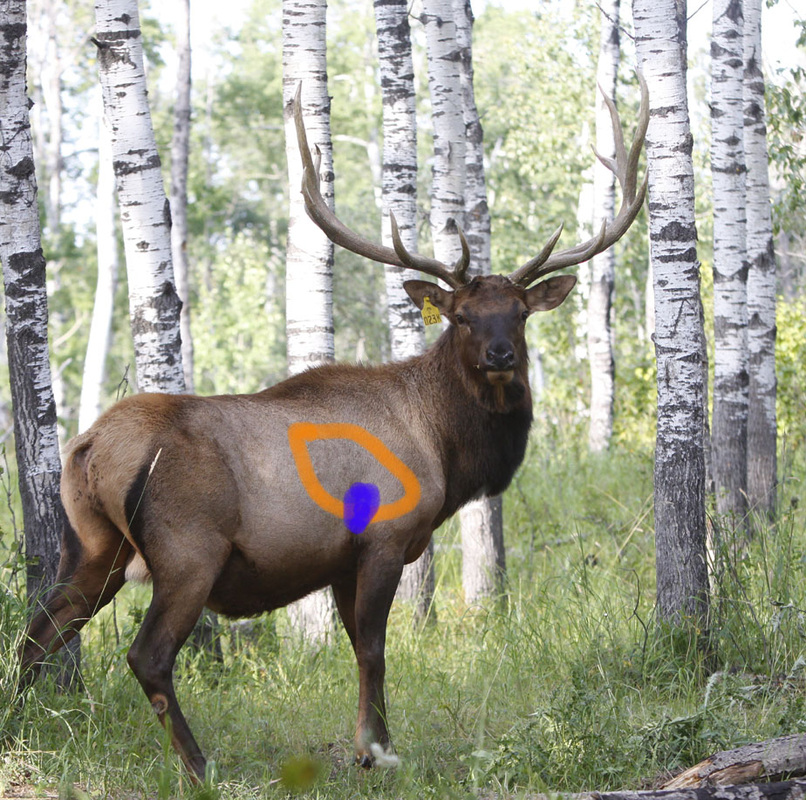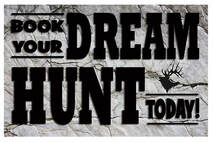Shot Placement on Silvertine Game
The whole purpose of this information is to avoid any difficulties and show you, my guests, the "Perfect Shot." The Photos show the placement of the Vitals. The orange ring represents the Lung area and the Blue represents the hearts placement. You will find information on Elk, Bison, Whitetail Deer, and Wild Boar.
ElkThe Elk is a tough critter, and many folks under estimate him. I am here to tell you he is as tough to knock over as any African game or larger beast I have guided to or killed. The good news is they are not bullet proof! Average range on our elk are very close, because of the timber on our estate, normally less than 50 yards. We will wait for the broadside shot, and you will shoot for the central lung shot just above the heart. In the photo you will see the body of the elk from the side, in the photo you will shoot for the bottom middle third of the chest. Depending on the angle of the elk you need to visualize where the heart lung area lies. With all shot on elk, the heart/ lung shot offers the greatest margin for error. Typically from a lung shot the elk will display very little initial reaction, but it should go down within a few minutes, elk are big, and they have a great will to live. As well the lung shot offers the advantage of ruining less edible meat. Learn where the heat and lungs are on the elk and use the photo as a guideline to where you would place the shot in relation to the body and foreleg. We do allow guys to make angling shots but ask that they make sure they come with enough gun and bullet top ensure enough penetration. We ask all clients have .30 caliber and up for elk.
|
BisonHere is the animal that inspired this web page of information, the good old Bison. Tipping the scales at well over a ton, the bison is typically a docile beast, unless wounded but we won't go there. The bison is a tough critter, and many folks underestimate him. Often times when he is shot he will not be subject to any bullet shock. He will calmly continue to feed or stand there, lie down, and eventually die. This process can take many minutes, often times leaving the hunter questioning if he hit him or not. This is where a good guide comes into play and watches for your shot placement to help you avoid things going sideways. Average range on our bison is 100 yards, and its open country. Typically we will wait to get set up for a broadside shot, and you will shoot for the central lungs, just above the heart. In the photo you will see the body of the bison from the side, in the photo you will shoot for the bottom middle third of the chest. Depending on the angle of the shot you need to visualize where the heart lung area lies. You will notice on Bison that the heart lies further forward than the deer or elk, so you need to tuck your bullet closer into the shoulder, or try and get set up with a slight quartering away shot. With all shots on bison, the heart and lung shot offers the greatest margin for error. The lung shot offers the advantage of ruining less edible meat. Learn where the heat and lungs are on the bison, and use the photo as a guideline to where you would place the shot in relation to the body and foreleg. We do not allow guys to make angling shot for their first one, but will on follow up shots. The bison is the ultimate animal for you to try out your larger caliber firearms on, so make sure come with enough gun and bullet top ensure enough penetration, as bison are THICK critters, and require more than the average elk sized game. We ask all clients have .338 caliber and up for bison, but the bigger the better. These principals and shot placement are the same for Yak, Water Buffalo, and other Wild Cattle that we offer hunts for.
|
Whitetail DeerAverage range on our whitetails is very close, less than 100 yards, and you will be able to place the shot absolutely perfect right.. My preference is the central lung shot, regardless of distances. In the photo you will see the body of the deer from the broadside pose, in the photo you will see in the bottom middle third of the chest. Depending on the angle of the deer you need to visualize where the heart lung area lies. With all shots on deer the heart lung shot offers the greatest margin for error. Typically from a lung shot the deer will display very little initial reaction, but it should go down within 60 seconds. The lung shot offers the advantage of ruining less edible meat. Learn where the heat and lungs are on the deer, and use the photo as a guideline to where you would place the shot in relation to the body and foreleg. We ask all clients have .25 caliber and up for whitetails.
|
Wild BoarThe Wild Boar is extremely tough, and often taken at close range in thick cover. They have a thick hide and even thicker layer of fat, so they DO NOT BLEED! It is essential to hit them hard and solid. The broadside shot is always the best, and even with their shield covering their vitals, a good high powered rifle or broad head will make it through. Now I said broadside, not quartering away or any other angle, as even a high powered rifle can "bounce off", I seen it happen. Wild hogs have a heart area that sits further forward , so it can be a bit tricky, it's not where you think it should be. So a immediate behind the shoulder shot on a deer can be fatal, but a wounded wild boar. You need to know where to shoot! Average range on our boars varies considerably from 5 yards to 50, because of the timber and swamps on our hog estates. We will shoot for the central lung shot just above the heart, right in the middle of the shoulder. In the photo you will see the body of the boar from the side, in the photo you will shoot for the bottom middle third to half way up of the chest, right in the shoulder. Also talk to your guide, as some of our European boars have large "Razorbacks", and middle body is too high. Depending on the angle of the boar, you need to visualize where the heart lung area lies. The shoulder/ lung/ heart shot offers the greatest margin for error. Typically from a lung shot the boar will show a reaction and run like the dickins, and it should go down within 60 seconds. Learn where the heat and lungs are on the boar and use the photo as a guideline to where you would place the shot in relation to the body, head, and foreleg. We do allow guys to make angling shots (Frontal), but ask that they make sure they come with enough gun and bullet top ensure enough penetration. We ask all clients have .25 caliber and up for meat boars, but .30 larger for our trophy boars that exceed 400 lbs.
|




